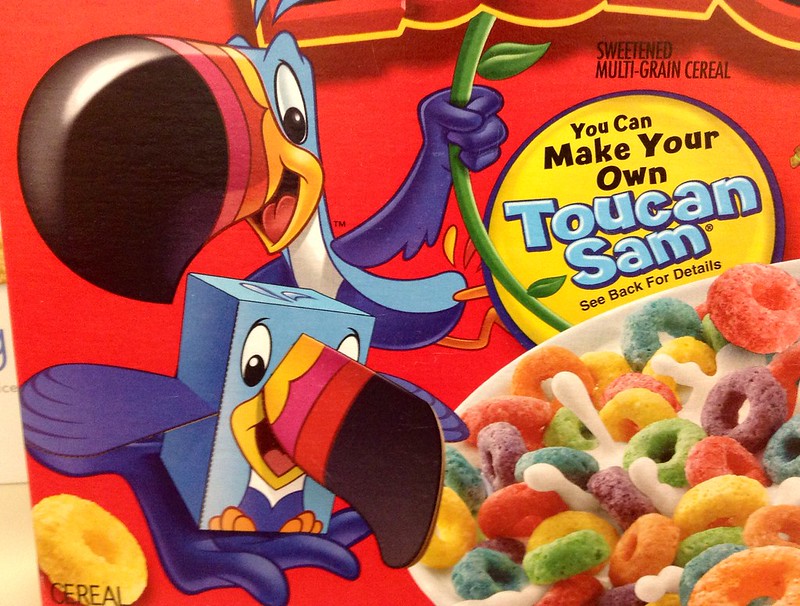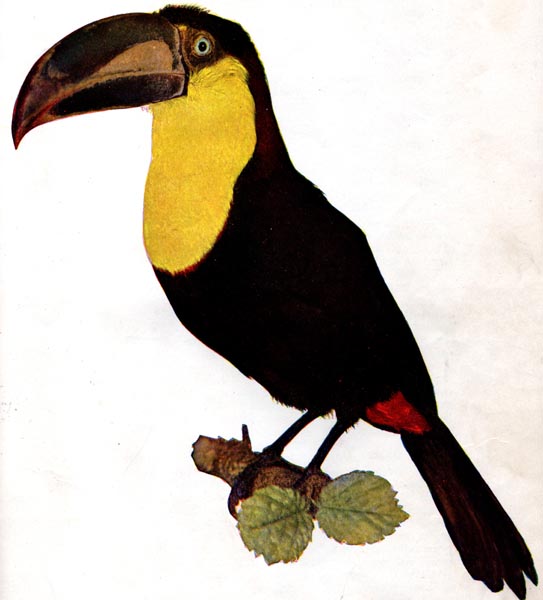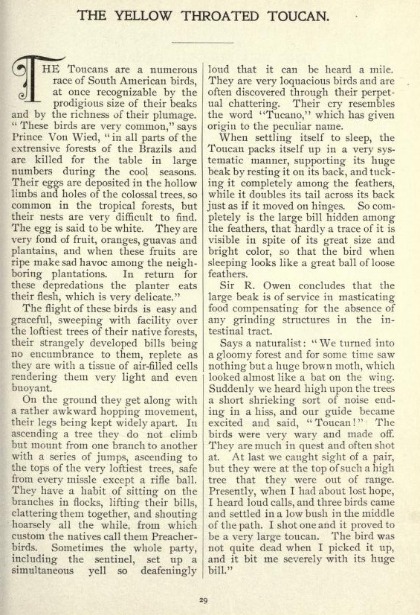American children have long learned about toucans from the box of Fruit Loops and in Disney movies. But well before Fruit Loops arrived on the scene, Birds: A Monthly Serial, also known as Birds: Illustrated By Color Photography, covered the Yellow Throated Toucan for young readers in its inaugural January 1897 issue. Today, we continue our review of the first issue of Birds by examining its two-part article on the Yellow Throated Toucan, beginning with a self-introduction from the bird itself and continuing with more information about our large-beaked friend from the editors.
You can follow along with my article with the original magazine at Project Gutenberg and The Internet Archive.

The Yellow Throated Toucan, Illustrated
This content begins with a portrait of the bird of the hour.

While the Yellow Throated Toucan is one of the less colorful birds that we have covered thus far, he in no way falls behind the others in terms of presence. Yellow and black makes for a striking two-color scheme – as bees know well. He stands first among equal among the birds of the issue in terms of his beak. Where the Cock-of-the-Rock’s beak was completely obfuscated from view by his feathers, the Yellow Throated Toucan’s beak would be impossible to miss.
Mr. Yellow Throated Toucan’s Self-Introduction

Like every bird in the issue thus far except for the Cock-of-the-Rock, the editors kindly allowed Mr. Yellow Throated Toucan to speak for himself. Below, in several subsections, I summarize his content.
Where Does Mr. Yellow Throated Toucan Live?
Mr. Yellow Throated Toucan tells us that he lives “in a very warm country.” That does not narrow things down much. However, we will have specifics later in the article.
What Does Mr. Yellow Throated Toucan Think Of His Appearance?
Mr. Yellow Throated Toucan notes his “handsome black coat” and “yellow vest.” It is a rather handsome coat.
Mr. Yellow Throated Toucan is not the only one who is fond of his appearance. “The people where I live like our yellow breasts.” Just to admire? “They wear them on their heads, and also put them on the ends of their bows.” Well, what would one of our bird articles be without something like that?
On The Matter of Mr. Yellow Throated Toucan’s Toes
Mr. Yellow Throated Toucan tells us that he has toes “like a parrot’s, two in front and two behind.” Interesting. Why so? According to our feathered friend, this toe arrangement helps him hold on to limbs. The feet are less suited for walking, however: “I cannot get along so well on the ground. I keep my feet far apart and hop.” In terms of hopping, the Yellow Throated Toucan is a bit like one common bird we covered outside of the instant series.
Finally, the Beak
The beak is a toucan’s stand-out feature. Since it is big, is it heavy? Not at all, says Mr. Yellow Throated Toucan. “[I]t is filled with air cells.” For that reason, his beak is “very light.” Surely thanks in part to the lightness of his beak, Mr. Yellow Throated Toucan can “fly very fast.”
Unrelated – Mr. Yellow Throated Toucan wonders whether you like his blue eyes.
Where Does Mr. Yellow Toucan Make His Home?
Mr. Yellow Throated Toucan “like[s] to sit in the top of the tallest trees.” There, where few other things roam, he is “not afraid.” In fact, “[n]othing can reach me there but a rifle ball.” As usual, our bird article turns a bit toward darkness.
Unsurprisingly, Yellow Throated Toucans conceal their nests. Before revealing the particulars, Mr. Yellow Throated Toucan wants to know if we will take the eggs from his nest. I trust that no true New Leaf Journal reader would do such a thing. For that reason, I can reveal that his nest “is in a hollow limb of a very high tree.”
On the Subject of Owls
“I do not like the owl, he is so ugly. When we find an owl we get in a circle around him and snap our great beaks, and jerk our tails up and down and scream. He is very much afraid of us.”
Well, that is terrible and it sounds a bit like bullying. We here at The New Leaf Journal are quite fond of owls. With that being said, perhaps there is some inter-avian conflict here that I ought not get in the middle of.
When the Yellow Throated Toucan Cries
What does the Yellow Throated Toucan sound like? Well, Mr. Yellow Throated Toucan informs us that sometimes he sits with other Yellow Throated Toucans in a tree, whereupon they “snap [their] beaks and shout.” That gave him and his fellow yellow-breasted friends the nickname “Preacher Birds.”
How loud is he? Mr. Yellow Throated Toucan states with just a hint of pride that he and his friends “may be heard a mile away.” What may you hear? “Tucano! Tucano!” Alas, he informs us with some regret that, while he thinks it’s a pretty song, “the people do not like it very much.” You can never satisfy everyone.
Yellow Throated Toucan Facts

Mr. Yellow Throated Toucan flew up high with some regret over the fact that many people do not appreciate his surely beautiful song. He yielded the stage to the editors of Birds, who came armed with facts about our large-beaked friend. In addition to facts, it also came armed with stories of deploying arms against our yellow-vested friend, but that should be expected by this stage in our series.
Where Do Yellow Throated Toucans Live?
The editors describe Toucans as “a numerous race of South American birds, at once recognizable by the prodigious size of their beaks and by the richness of their plumage.” According to eBird.org, the yellow throated toucan has a range from Honduras in Central America to the very northern and western edges of South America. It can be found in parts of Honduras, Nicaragua, Costa Rica, Panama, Peru, Ecuador, Colombia, and Venezuela.
The editors quoted a Mr. Prince Von Wied, who reported that the Yellow Throated Toucans “are very common” in their region. Mr. Von Wied explained that the poor birds were “killed for the table in large numbers during the cool seasons.” I must say that I did not at any point think of dinner when viewing the Yellow Throated Toucan.
Today, the Yellow Throated Toucan’s conservation status is “Near Threatened.” While that’s not the optimal status of “Least Concern” I suppose that it’s still doing well enough on the whole.
On Nests and Eggs
Despite the Yellow Throated Toucan’s commonness, Mr. Van Wied noted that “its nests are very difficult to find.” Mr. Van Wied seconded our friend from earlier, stating that “[t]heir eggs are deposited in the hollow limbs and holes of the colossal trees.”
What color are Yellow Throated Toucan eggs? Are you expecting something exciting, befitting of such a bright bird? “The egg is said to be white.” Well, that was surprisingly ordinary. We were told that the Cock-of-the-Rock lays multi-colored eggs. Even chickens can lay brown eggs.
On Diet
Mr. Van Wied reported that Yellow Throated Toucans “are very fond of fruit, oranges, guavas and plantains…” Rather than find their own fruit in the wild, they had a tendency to raid nearby plantations. Mr. Van Wied tell us that the planters got their revenge, because of course we must veer into eating Yellow Throated Toucans: “In return for these depredations the planter eats their flesh, which is said to be very delicate.” I still do not see dinner when I look at the Yellow Throated Toucan, but that is just me.
I will note that none of the contemporary sources I looked at have much to say about eating Yellow Throated Toucans, so perhaps it is less in vogue than it was in 1897.
In a lighter note, a Sir R. Owen concluded, according to the editors, “that the large beak is of service in masticating food compensating for the absence of any grinding structures in the intestinal track.” For those who are interested, Cornell’s eBird site does have pictures of the Yellow Throated Toucan eating.
On Flight
The editors report that “[t]he flight of these birds is easy and graceful, sweeping with facility over the loftiest trees of their native forests…” This may surprise some given their large beaks, but Mr. Yellow Throated Toucan spoiled the secret of their beaks before. The editors continued: “[T]heir strangely developed bills being no encumbrances to them, replete as they are with a tissue of air-filled cells rendering them very light and even buoyant.” That is a well-written passage.
On Walking, Or Hopping
As graceful as the Yellow Throated Toucan is in the air, as Mr. Toucan admitted, it is far less so on the ground. “On the ground they get along with a rather awkward hopping movement, their legs being kept widely apart.” However, their hopping does serve them well in climbing, we are told: “In ascending a tree they do not climb but mount from one branch to another with a series of jumps, ascending to the tops of the very loftiest trees, safe from every missile except a rifle ball.” The editors lifted the rifle ball line from a bird. Plagiarism is not cool.
Aside, I have seen pigeons hop to high places – but it is probably less dramatic than what the Yellow Throated Toucan does.
On Social Gatherings
Yellow Throated Toucans apparently believe in strength in numbers. As Mr. Toucan had also described, “They have a habit of sitting on the branches in flocks, lifting their bills, clattering them together, and shouting hoarsely all the while, from which custom the natives call them Preacher-birds.” When the Yellow Throated Toucan party yells together, they “set up a simultaneous yell so deafeningly loud that it can be heard a mile.” That sounds unpleasant for all persons and creatures within the mile.
The editors state that the Yellow Throated Toucans are “very loquacious,” and that their “perpetual chattering” often gives away their presence. That their cry sounds like the word “Tucano” is what gave the Toucans their name.
For those who want to hear the birds in action, eBird has a large library of recordings.
On Slumber
The Yellow Throated Toucan is apparently very particular about how it sleeps. “[T]he Toucan packs itself up in a very systematic manner, supporting its huge beak by resting it on its back, and tucking it completely among the feathers, while it doubles its tail across its back just as if it moved on hinges.” Although you would hardly think it possible from seeing a picture of the bird when it is awake, “[s]o completely is the large bill hidden among the feathers, that hardly a trace of it is visible in spite of its great size and bright color, so that the bird when sleeping looks like a great ball of loose feathers.”
Although I did not find any Yellow Throated Toucan sleeping pictures, I did find a picture of a different sleeping Toucan on the Adventures in Toucanland blog for those who want to see what the editors meant. Sure enough, Toucans can just about make their beaks disappear when sleeping. The more you know.
Hunting Stories
In our last bird article on the Red Bird of Paradise, stories of Red Bird of Paradise hunting were relevant to how the bird obtained its name. Here, we conclude with a somewhat random Yellow Throated Toucan hunting story, wherein a naturalist managed to shoot one out of the air thanks in large part to its yelling loudly as it flew. Our article here concludes with when the naturalist went to retrieve his prize, only to discover that it was still alive when it “bit [him] severely with its huge bill.”
Unrelated Story of Past Bird Trauma
That reminds me of a story from my past. While I have never shot a bird, I have fed them with birds seeds and bread. On one occasion when I was much younger, I was feeding geese bread. At one point, I held on to a piece of bread just a touch too long. The goose bit my finger along with the bread. It hurt. The goose was unperturbed.
Suffice it to say, I probably would not try to feed a Yellow Throated Toucan.
Chomping Down and Out
The Yellow Throated Toucan article was one of the more informative bird articles that we have reviewed in terms of facts about the bird, although the editors’ commentary repeated the bird’s self-introduction more than most prior articles. The content mostly holds up well today, and would make fine reading for today’s children, perhaps minus some of the typical gratuitous bird violence and some bullying. With that noted, it seems the editors voiced fewer objections to bird violence than they did in some prior pieces, such as the one about the Resplendent Trogon. Did they have a bad experience with the Yellow Throated Toucan? Was the naturalist who was bitten on the Birds staff? I have questions.
Furthermore, it just occurred to me that we never received an explanation for why the Yellow Throated Toucans hate the owls. I was looking forward to getting to the bottom of that issue. Instead we learned that some people think Yellow Throated Toucans taste good. The mystery continues.
We are down to the final two birds of the issue. Next time, we will review the Red-Rumped Tanager. You will never guess what color he is.